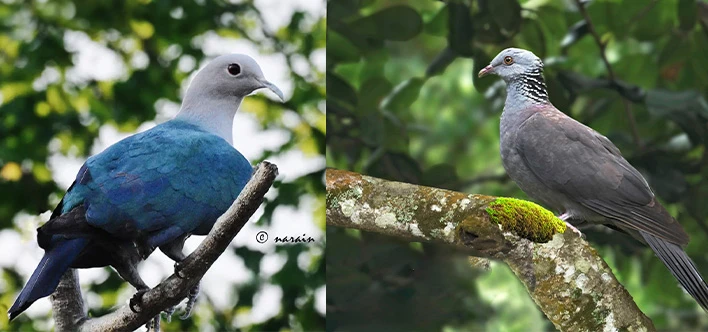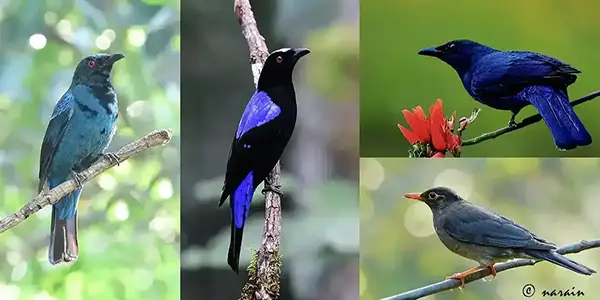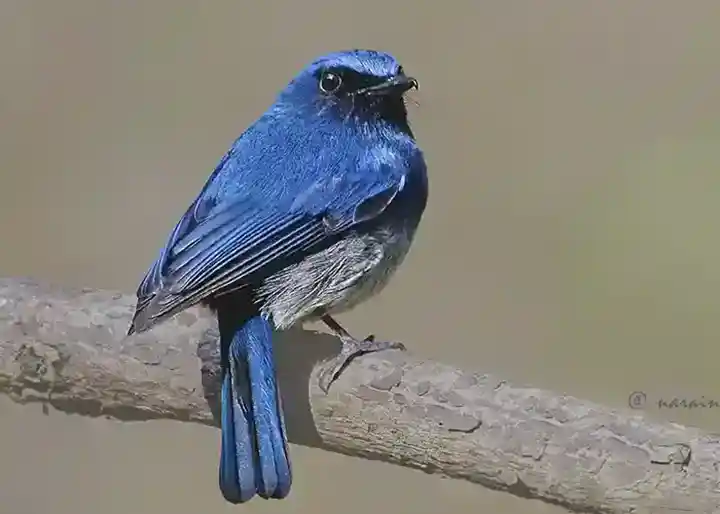THE BLUE AND GREY BIRDS OF INDIA, THE SKYWARD SPLENDORS
Join me on a photographic journey, into the captivating world of stunning blue and grey birds of India. From the majestic blues of the azure-winged Malabar Whistling Thrush, Nilgiri Flycatchers and Indian Blue Robins to the subtle greys of the Brahminy Starlings, Nilgiri Wood Pigeons and Malabar Grey hornbills, the blue and grey birds’, list goes longer. As a wildlife enthusiast, I’ve had the privilege of capturing these beautiful species in their natural habitats. Their soothing blue and grey colors have a way of calming the soul, reminding me of the beauty that awaits just beyond the lens. Here, I showcase, my favorite images, sharing insights into the world of these incredible birds.
FLYCATCHERS
Flycatchers are agile and lively birds. These small to medium-sized birds are found worldwide, spread across diverse habitats. I would vouch they form a single group of Birds of India with a stunning Blue and Grey color. Flycatchers are often seen perched on exposed branches or wires, scanning their surroundings for potential prey. Their diet primarily consists of insects, which they expertly catch mid-air or pluck from vegetation. With their striking plumage and dynamic behavior, flycatchers are favorite among birdwatchers and photographers.

(The birds’ images above represent Sholakili, Nilgiri flycatcher( Male & Female ), Cinereous Tit and Black-napped Monarch, boasting their vibrant Blue and Grey colors.)
Flycatchers inhabit diverse environments worldwide, including tropical, subtropical, and temperate forests, from dense rainforests to open woodlands, open grasslands, marshes, swamps, hills, valleys, and mountain slopes as well.

(The image posted here represents, While bellied Blue flycatcher, Tickell’s Blue, Verditer flycatcher, Kashmiri flycatcher and the Indian Blue Robin. We can see that all these birds boast of their prominent plumage with vibrant blue and grey colors)
STARLINGS AND MUNIAS
Starlings / Mynas & Munias are the two distinct groups of birds belonging to the same family with the stunning blue and grey color among the Birds of India. Munias are small, finch-like birds, known for their exciting colors and intricate patterns. They inhabit grasslands, forests, and backyards, feeding on seeds, fruits, and insects. Mynas, on the other hand, are larger and more adaptable, with a mixed distribution. These birds are recognized by their glossy plumage, distinctive calls, and peculiar behavior. Mynas are opportunistic omnivores, eating fruits, insects, and even small vertebrates.
While the Common Myna inhabits in the Urban areas, agricultural lands, and forest edges,
the lesser hill myna inhabits in the hilly terrains , forests, woodlands and grasslands along the terrain. But the Munias in general, inhabit in the open grasslands, savannas, and meadows and
the forest edge. The Red Munias takes to the grasslands, open woodlands, and agricultural areas.

(The image posted here represents, Brahminy Starling, Lesser Hill Myna, Red Munia-(female) and Common Myna. With their striking dull to dark grey colors, the Lesser Hill Myna boast a glossy blue mixed beautifully with black on the nap and the mantle , with a dark grey underpart.)
ROLLERS AND BEE-EATERS
Rollers are medium-sized, brightly colored birds with distinctive rolls in flight, found in tropical and subtropical regions. Bee-eaters on the other hand, are sleek, colorful birds with long, curved beaks, feeding on insects, mainly bees and wasps, in open and sunny areas.
The Indian Roller displays stunning blue and grey plumage with a pale blue throat, green mantle and orange-brown bill. Found throughout the Indian subcontinent, it inhabits open forests, grasslands, and agricultural areas.
The European Roller sports a bright blue and green plumage with a pale blue throat and black stripe above its eye. This is a migrant bird for the South. It breeds in open forests and grasslands.
The Blue-tailed Bee-eater boasts brightly colored plumage – blue throat, green back, yellow belly, and vibrant blue tail feathers. Found in tropical , it inhabits open forests and grasslands.
The Blue-bearded Bee-eaters have a striking bright colored plumage & blue throat, with green back and pale bluish and greenish feathers. These birds also inhabit in open forests and grasslands.

(The images posted here represent Indian Roller, Blue bearded bee-eater, Blue tailed bee-eater, and European Roller.)
KINGFISHERS
Kingfishers are the large-headed, big-billed birds perching and searching along the waterways, diving for fish, tadpoles and other invertebrates. Larger birds often goes for frogs, snakes and rodents in addition to fish. These species have striking plumage and loud calls.
However both the Common and Blue eared are having a very striking Blue and paler greenish upperparts in addition blue eared kingfisher has a vibrant blue covering the ears, as it’s name goes.
But, the Oriental Dwarf Kingfishers have very striking blue-black forehead and ear patch while the nap and crown has variable violet with indigo mixed colors. These birds shine under the light, making the color more vivid and vibrant.,
While the common kingfishers are widespread residents, the Oriental Dwarf and Blue eared are migrants to the South. Commoners are found near slow-moving or still water bodies like rivers, lakes, and ponds while the blue eared prefers dense, tropical forests near streams and rivers. The oriental dwarfs inhabits lowland forests, tropical and subtropical moist forests, and areas near streams

(The image posted here represents vibrant colored Oriental Dwarf Kingfisher, Common Kingfisher and the Blue eared Kingfisher.)
PIGEONS
Stout-bodied, small to large birds with distinctive calls, found in diverse habitats, from urban cities to forests. Nilgiri wood pigeon and Nilgiri Imperial Pigeons are the birds with grey and deep sea blue colors. The Nilgiri Wood Pigeon features dark gray-brown plumage with a distinctive black band on its neck. Its belly is paler, with white bars. Endemic to the Nilgiri Hills in southern India, it inhabits hilly forests. The Nilgiri Imperial Pigeons boast dark gray-brown plumage with a pale gray neck patch and white bars on its belly. This large pigeon is endemic to the Nilgiri Hills in southern India, inhabiting in deep forests.
(The posted images represent Nilgiri Imperial Pigeon and Nilgiri Wood Pigeon )
BLUE BIRDS
The Indian Black Bird, Asian Fairy Blue Birds and Malabar Whistling Thrushes are the other three striking birds with more vibrant blue and grey colors.
The male Asian Fairy Bluebird sports vibrant blue plumage, while the female has gray-brown plumage. The immature one has very pale blue plumage with patches of dark blue all over its body. They inhabit tropical forests and open woodlands.
The Indian Blackbird displays glossy grey to black plumage. Males have a distinctive black crest. They inhabit forests, gardens, and urban areas.
The Malabar Whistling Thrush has a deep blue-blackish forehead and shoulders while their wings and tails are edged with glistering blue. This bird inhabits moist, tropical forests in the Western Ghats of India.

(The image represents Asian Fairy Blue Birds and Malabar Whistling Thrush and the Indian Black Bird)
DRONGOS
Drongos are per se noisy birds with different mimic and harsh calls. They are also capable of making pleasant whistles.
Both the Racket Tailed and Black Drongo boast their stunning bluish black plumage often sheen with the glossy & shiny bluish purple. Excepting for the belly, the upper part of the white-bellied drongo, also glitters with bluish black. These birds are widespread resident inhabiting various environments, from forests to urban areas and bamboo Jungles.

MALABAR GREY HORN BILL and others
I mention here below, few stunning blue and grey birds of India, which may form an odd group.
Malabar Grey Hornbill: Considered to be one of birds larger in size, the Malabar Grey Hornbill features grey plumage with a white throat and distinctive black horn-like casque on its bill. Endemic to the Western Ghats of India, it inhabits tropical forests.
Velvet-fronted Nuthatch:
The Velvet-fronted Nuthatch boasts gray-brown plumage with a distinctive black stripe above its eye and reddish-brown vent. It inhabits forests and woodlands.
Pond Heron:
The Grey Heron, also known as the Indian Pond Heron, displays grayish-white plumage. They are Found in wetlands and ponds across the Indian subcontinent.
White-breasted Water hen:
The White-breasted Water hen features grayish-brown plumage. Found in wetlands. And marshy areas and ponds.

(The image here represents White breasted water hen, Grey Heron, Velvet fronted Nuthatch and Malabar Grey Horn BiLL.)
WHERE TO SITE THESE BIRDS ?
These birds were photographed, at various locations in the Western ghats, more specifically in the Nilgiris, Munnar, Thattekad, Chinnar, Palakkad and Coimbatore outskirts.
HOW TO REACH, THE BEST SEASON TO VISIT ETC.,
These aspects were covered extensively in my blog-posts, already published. For your quick reference, I do place the relative links here below.
Most Popular Birding Locations in Nilgiris
Top 2 Birding Hot spots of Kerala
CONCLUSION, WITH A COMMITMENT TO CONSERVATION.
As I conclude this journey through the realm of stunning blue and grey birds of India, we’re left with an indelible impression of their beauty and diversity. May their captivating colors spark a sense of awe and curiosity, in addition to encouraging us to explore and learn further.
The mesmerizing blues and greys of these bird species remind us of nature’s breathtaking artistry. The blues and greys of these avian wonders serve as a poignant reminder of the beauty, resilience, and fragility of life on Earth. The list does not obviously include each and every birds boasting the Blue and Grey. There are still many to explore. However, as we gaze upon their majestic forms, let us renew our commitment to conservation, ensuring these radiant hues continue to brighten our world for years to come


It’s so eloborate and extensive.
Images’ are beautifully presented.
Good lucks..